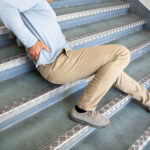
When you slip and fall while you’re out and about, it’s reasonable to assume the property owner—or, in some cases, the occupier—is liable. Before you can hold them financially accountable, though, you’re going to have to convince the insurer that they were, in fact, negligent. You’re also going to have to present compelling evidence that demonstrates damages.
Let’s take a look at the kinds of evidence that can help you prove liability and losses, so you can build the strongest case possible:
1. Surveillance Footage
If you slipped at a business establishment, there’s a good chance the accident was captured by surveillance cameras overlooking the scene. The footage will probably be overwritten in a matter of months—if not weeks—though, so if it happens to be available, you’ll want to reach out as soon as possible to request copies. Your attorney should demand that the video footage be preserved. If the business fails to do that it faces legal consequences when the case goes to Court.
2. Photographs of the Scene
Were you able to photograph the hazard in question that caused you to slip? If so, store the images in a safe place until you can give them to your legal team.
If you were unable to capture the scene of the accident, ask a loved one to return and photograph the area as soon as possible. Even if the property owner addressed the hazard that was responsible for the incident, images of the scene in general can still support your claim.
3. Eyewitness Testimony
Statements from those who saw what happened won’t serve as irrefutable proof of liability, but the details they contain could at least corroborate your own version of events. If you were able to get the names and phone numbers of any eyewitnesses before leaving the area, give them to your legal team. Your attorney will want to reach out while the details are still fresh in everyone’s minds.
4. Medical Records & Other Evidence of Injury
Your medical records will inevitably provide the foundation for your damages claim. These might include diagnostic images, hospital logs, and progress reports. Generally speaking, you’re going to want to present anything that shows your injuries are consistent with the slip and fall.
5. Journal Entries
In California, personal injury claimants are entitled to seek compensation for non-economic damages like diminished quality of life. Since such losses are not accompanied by any documentation, though, you must find another way to show their extent. This is where journal entries can come in handy.
Slip and fall attorneys advise clients to start writing daily entries as soon as possible after getting hurt. Keeping a log about the hurdles you face as a result of your injuries will be invaluable when it comes time to demonstrate your non-monetary losses.
Discuss Your Claim with a Slip and Fall Attorney in Long Beach
Your Injuries Are Personal to Me
If you’re hoping to hold a property owner liable for failing to maintain their premises, you can count on the Law Office of Michael D. Waks for strategic guidance every step of the way. Michael D. Waks is a top-rated trial attorney who always goes to bat for his clients. To schedule a free case review with a slip and fall lawyer in Long Beach, fill out our Contact Form or call (562) 206-1939.
- How Settlement Values Are Determined in California Personal Injury Cases - April 9, 2025
- How Can Evidence Be Preserved After a Personal Injury Accident - April 2, 2025
- How Do Emotional Distress Claims Work In Personal Injury Cases? - March 20, 2025